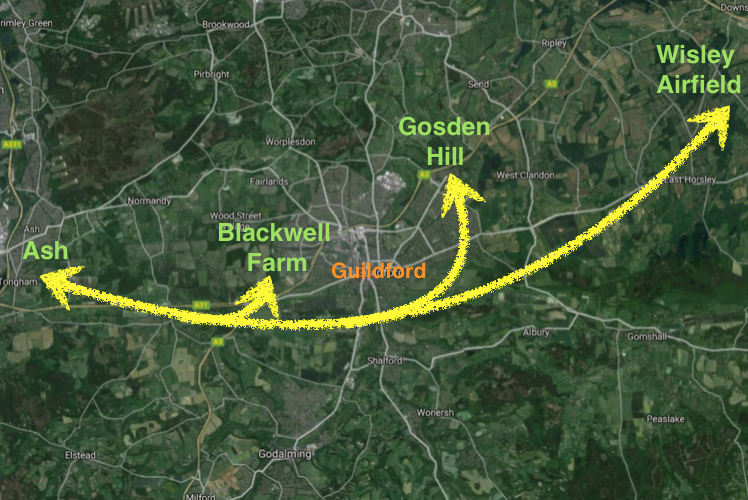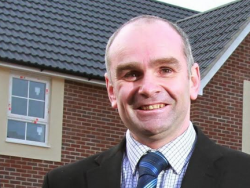 Abraham Lincoln
If given the truth, the people can be depended upon to meet any national crisis...
Abraham Lincoln
If given the truth, the people can be depended upon to meet any national crisis...
 Guildford news...
for Guildford people, brought to you by Guildford reporters - Guildford's own news service
Guildford news...
for Guildford people, brought to you by Guildford reporters - Guildford's own news service
Councillors Sceptical Of Property Consultants Support For Green Belt Swap Proposal
Published on: 7 Dec, 2016
Updated on: 12 Dec, 2016

An illustration of the areas of green belt that might be included in a swap to create additional green belt in Ash
A local property consultants company which has stated support for the government’s green belt swaps proposal has been dismissed by local leading councillors. They question whether the consultants are familiar with the existing proposal in Guildford’s draft Local Plan and the scarcity of undesignated green space sites.
In a press release, Bruton Knowles’ Guildford office says that it welcomed a government white paper which sets out mechanisms for “swapping” green belt development land.
Town planner Paul Barton, who advises the Guildford office, said the idea – to lift protection from likely development land inside the green belt and bolt it on elsewhere – could be one way out of the UK’s housebuilding impasse.
“We have argued for some time that building strictly within brownfield sites will not deliver new homes in the volume needed to satisfy demand.”
The press release says: “The problem is particularly acute in and around Guildford – where house prices average £340,000 and almost ninety per cent of the borough falls within the Green Belt.”
Barton continued: “Venturing on to green belt sites generally provokes widespread opposition from countryside agencies and neighbours – a great many of which appear to be sufficient to defeat proposals being brought forward.
“Enabling developers to propose land swaps could be an effective means of influencing opinion on otherwise sustainable sites within the green belt.”
“On the face of it, it seems a good idea that if protected land is lost, then protected land is created elsewhere, although no doubt some will argue doing so will assist urban sprawl, something the green belt was created to restrain.”
“We will need some clarification on how proposed swap deals are going to stand up to scrutiny as ‘green belt’ but it’s clear these sort of ideas should be looked at very carefully by all stakeholders whether local or national if we are to move forward.”
But senior local councillors were critical. Council leader Paul Spooner (Con, Ash South & Tongham), referring to the creation of new green belt areas in Ash, said: “Has Bruton Knowles studied the draft Local Plan and the proposed green belt swap already there? No further land is available for further swaps as all land being green belt is already allocated.”
Leader of the opposition, Caroline Reeves (Lib Dem, Friary & St Nicolas) was also dismissive: “This strikes me as wishful thinking on the part of the property consultants.
“Since so much of Guildford is green belt already, there’s little scope for new green belt apart from the Ash area, and that has already been proposed in the draft Local Plan.
“The villages are currently in the green belt and there would be few who would want to swap, unless perhaps it was in their immediate area, but there’s nothing for the villages to use to swap.”
Susan Parker leader of the Guildford greenbelt Group, was critical of any kind of green belt development: “The essential characteristic of green belt is its permanence. Once we start eroding green belt, by “swapping” it, we will eventually lose it. Commercial justification can be made for any development proposal. Money is not the only thing that should matter to our society. We can’t breathe money.
“Of course estate agents welcome selling homes to Londoners. But why should their profit destroy the quality of our lives, and our children’s lives? Once countryside is gone, it is gone forever. There’s enough brownfield land in the South East to provide homes for ten years. For all our sakes, we must retain our green belt.”
But Paul Barton said that while critics might decry the “watering down” of the green belt he felt some compromise was required.
“The government has given the strongest possible hints that they are prepared to look at areas of the green belt once considered sacrosanct – and we agree a more realistic scheme is necessary to cope with the enormous increase in populations since it was brought in during the 1930s.
“In our view, realistic amendments such as land swaps will protect a greater area of the green belt in the longer term than simply building the barricades against any sort of development, ever.”
Responses to Councillors Sceptical Of Property Consultants Support For Green Belt Swap Proposal
Leave a Comment Cancel replyPlease see our comments policy. All comments are moderated and may take time to appear.
Recent Articles
- Guildford Institute’s Crowdfunding Project for Accessible Toilet in its New Community and Wellbeing Centre
- Letter: Guildford – Another Opportunity Missed?
- Letter: GBC’s Corporate Strategy – Where Is the Ambition?
- My Memories of John Mayall at a Ground-breaking Gig in Guildford Nearly Six Decades Ago
- Westborough HMO Plans ‘Losing the Heart of the Street’ Says Resident
- College Invests to Boost Surrey’s Economy and Close Digital Skills Gap
- Community Lottery Brings Big Wins for Local Charities
- GBC Housing Plan Promises ‘A Vibrant Urban Neighbourhood’ Near Town Centre
- Hospital Pillows ‘Shortage’ at the Royal Surrey
- Updated: Caravans Set Up Camp at Ash Manor School


Recent Comments
- Ian Macpherson on Updated: Main Guildford to Godalming Road Closed Until August 1
- Sara Tokunaga on GBC Housing Plan Promises ‘A Vibrant Urban Neighbourhood’ Near Town Centre
- Michael Courtnage on Daily Mail Online Reports Guildford Has Highest-paid Council Officer
- Alan Judge on GBC Housing Plan Promises ‘A Vibrant Urban Neighbourhood’ Near Town Centre
- John Perkins on GBC Housing Plan Promises ‘A Vibrant Urban Neighbourhood’ Near Town Centre
- S Collins on GBC Housing Plan Promises ‘A Vibrant Urban Neighbourhood’ Near Town Centre
Search in Site
Media Gallery
Dragon Interview: Local Artist Leaves Her Mark At One of England’s Most Historic Buildings
January 21, 2023 / No Comment / Read MoreDragon Interview: Lib Dem Planning Chair: ‘Current Policy Doesn’t Work for Local People’
January 19, 2023 / No Comment / Read MoreA3 Tunnel in Guildford ‘Necessary’ for New Homes, Says Guildford’s MP
January 10, 2023 / No Comment / Read More‘Madness’ for London Road Scheme to Go Ahead Against ‘Huge Opposition’, Says SCC Leader
January 6, 2023 / No Comment / Read MoreCouncillor’s Son Starts Campaign for More Consultation on North Street Plan
December 30, 2022 / No Comment / Read MoreCounty Council Climbs Down Over London Road Works – Further ‘Engagement’ Period Announced
December 14, 2022 / No Comment / Read MoreDragon Interview: GBC Reaction to the Government’s Expected Decision to Relax Housing Targets
December 7, 2022 / No Comment / Read MoreHow Can Our Town Centre Businesses Recover? Watch the Shop Front Debate
May 18, 2020 / No Comment / Read More














Jules Cranwell
December 7, 2016 at 4:24 pm
For goodness sake, would our councillors stop perpetrating the myth that the UK has a housing crisis. It doesn’t! There may be a crisis of demand in the South-East, but there is no shortage of housing and suitable brownfield development land throughout the rest of the UK.
The real issue is a legacy of underinvestment outside the South-East, which should be addressed.
As for green belt ‘swaps’ this debate exposes the fact that the leader of the council, and lead councillor for the draft Local Plan, is overseeing such a proposed swap, giving new green belt to his manor, at the expense of e.g. Wisley, Ockham, and Blackwell Farm.
Valerie Thompson
December 7, 2016 at 5:26 pm
What land are the developers proposing to use for “swaps”?
Either the countryside is already green belt and, so-far, still protected, or it’s farmland, or woodland, or it belongs to some organisation like the National Trust.
The designations such as ‘green belt’ or ‘conservation area’, or ‘SSSI’ already exist. Further protection should not be necessary, neither should these areas be designated as something else.
GBC councillors will need to be vigilant in their refusals of inappropriate planning applications. Land cannot be created. God did that and it’s finite.
Ben Paton
December 7, 2016 at 7:58 pm
Wisley Property Investments has promoted the idea in its planning applications and website that the council could compensate for the loss of the green belt at Ockham (it has not been an airfield for many years) by designating land in Ash as new green belt.
At first sight this might appeal to councillors. But it is not as straightforward as is implied.
The National Planning Policy Framework has this to say at para 82
“The general extent of green belts across the country is already established. New green belts should only be established in exceptional circumstances, for example when planning for larger scale development such as new settlements or major urban extensions. If proposing a new green belt, local planning authorities should:
● demonstrate why normal planning and development management policies would not be adequate;
● set out whether any major changes in circumstances have made the adoption of this exceptional measure necessary;
● show what the consequences of the proposal would be for sustainable development;
● demonstrate the necessity for the green belt and its consistency with Local Plans for adjoining areas; and
● show how the green belt would meet the other objectives of the framework.
Showing “exceptional circumstances” for the creation of new green belt is not easy. Why would existing landowners agree to have their existing development rights removed in perpetuity?
Creating and destroying green belt across the borough would just create uncompensated transfers of value. To put it more bluntly it would make people who persuade the council to remove their agricultural land from the green belt multimillionaires. And it would reduce the value of land put into new green belt.
Landowners whose rights have been prejudiced in this manner have taken their complaints to the Court of Appeal – and won. Perhaps the most famous case is that of COPAS & Anr vs Royal Boro of Windsor & Maidenhead in 2001.
COPAS objected to its land being included in new green belt and appealed to the Court of Appeal – where it won. The judge said: “I would hold that the requisite necessity in a … case like the present – where the revision proposed is to increase the green belt – cannot be adjudged to arise unless some fundamental assumption which caused the land initially to be excluded from the green belt is thereafter clearly and permanently falsified by a later event.” Other similar cases have been heard by the Court of Appeal, such as the Carpets of Worth case.
For a council eager to build on the green belt the notion of ‘swaps’ is seductive. It is presumably especially seductive when members of the council hold influential positions (such as Leader and Lead Member for the Local Plan) and represent wards in which the draft local plan expressly seeks to limit new development by creating new green belt.
The draft local plan states at para 7.8: “Additional green belt land has been designated around the Ash and Tongham urban area and Ash Green in part to provide ongoing separation between the settlements and in part a reflection of the quantum of development recently completed and proposed within the area.”
Prima facie this does not comply with the NPPF. How does land at Ash serve the purposes of the Metropolitan Green Belt of London? Is this not further evidence that the new draft Local Plan is based on political considerations rather than evidence and the rule of law?